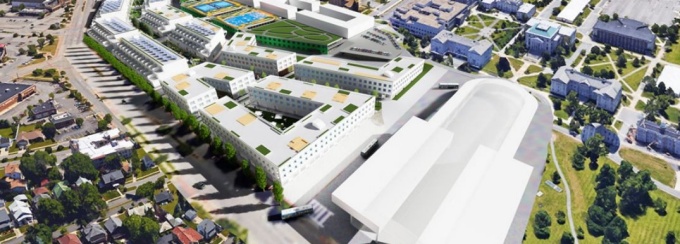Transit oriented development
Concepts for University Station (Buffalo Metro Rail)

Image source: ARC 607-2 / ARC 609 | Transit Oriented Development in University Heights
In many places across the US, and around the globe, development around public transit stations is on the rise. Known as transit-oriented development (TOD), this type of development maximizes the amount of residential, business, and leisure space within walking distance of public transit. University Station, a Metrorail Station in the University Heights neighborhood, and on the “front lawn” of UB’s South Campus, sits amidst a number of large surface parking lots that present vast potential for TOD.
In this interdisciplinary studio, graduate students from the school’s real estate, architecture and planning programs worked together to examine the possibilities for TOD to make transformative impacts on UB’s South Campus, the University Heights neighborhood, and the City of Buffalo. Students worked in four separate teams, each producing its own development proposal for the area surrounding the station.
Major Themes and Takeaways
In consultation with the four student teams, faculty leading this studio offer these takeaways regarding the feasibility, benefits, and key considerations of a transit-oriented development on the University at Buffalo South Campus:
- Re-development of parking lot sites could close the considerable distance that separates South Campus buildings, activities, and people from Main Street and the University Heights neighborhood, and in a manner that preserves the character of the campus and viewsheds to major landmarks like Hayes Hall.
- Greater connectivity between the campus and the University Heights neighborhood would result from “inviting” the existing street grid into the campus, and by incorporating “complete street” and traffic calming measures along Main Street.
- Redesigning the above-ground elements of the Metro Station, to create a safer, more pedestrian-friendly area is critical to the future success of the South Campus and the University Heights neighborhood.
- Incorporating amenities on the South Campus that would be accessible to the community, such as park areas and other green space, is important to both UB and the neighborhood. Teams hypothesized different ways that this could be done, including a restoration of natural features in and around the escarpment that is located at the northeast end of the site.
- As recommended in the UB 2020 Plan, the relocation of professional schools, such as the law and business schools, to the South Campus from the North Campus, will bring those school faculty and students into a closer relationship with the downtown Buffalo CBD, where courts and major business are located. Right now, without a vision for creating more attractive improvements to the South Campus, it would be hard to convince these schools to relocate.
- Through design solutions the South Campus could become an innovation hub and provide facilities to support the wellness and healthy lifestyles of UB faculty, staff and students, as well as University Heights residents.
- Consider relocating community-oriented research programs on the South Campus closer to Main Street and the community.
- The most promising uses for these site include multi-family residential, (flexible) office, hotel, and retail, in approximately that order. Multi-family was demonstrated to be the most successful use in terms of market demand and financial feasibility, and should include affordable, workforce, and student housing. Office is recommended to be “flexible” with co-working or other non-traditional professional offices. A hotel use would complement an innovation hub, professional school relocations, and executive education programming. Finally, retail largely would serve as an amenity to activate the site and provide life to Main Street.
- From a financial standpoint, acceptable investment returns can be obtained by a developer/investor, and pro forma financial models appear to support the payment of a ground lease to NYS, if a project is undertaken as a public/private partnership, with incentives such as real estate abatements and tax credits, and a combination of creative tax-exempt and taxable (conventional) financings.
Fall 2017 | ARC 607-2 / ARC 609 | Transit Oriented Development in University Heights
Instructors: Hiro Hata & Mark Forester
Students:
Team 1: The Hub
Courtney Cox
Anthony Garofalo
Mitch Larosa
Wonho Lee
Kai Sun
Team 2: Hayes Hill
Yimo Liu
Eamon Riley
Wenzhuo Shao
Devanshi Shastri
Chris Tringali
Team 3: The Heights
Kyle Fecik
Zhuoshu He
Connor Kenney
Lindsay Macaluso
Carl Reeves
Dhwani Shah
Team 4: The Corridor
Bill Dolan
Euy Chan Jeong
Mun Sung Koh
Unnati Patel
Dennis Playfair
Dan Theobald